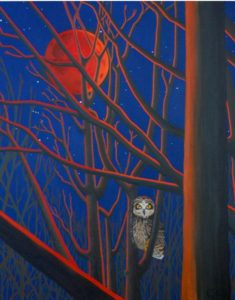Hallowe’en Story: The Witches of Rama

Submitted by Laurie Leclair
Between the years 1915 and 1918, several members of the Rama First Nation worked with George E. Laidlaw, a retired army colonel and semi-professional archaeologist in an ethnographic project aimed at the preservation of Anishinabek stories. Together, the team was able to collect and recount over 100 stories, the great majority of them dealing with the supernatural. Laidlaw published these stories in several installments under Ontario’s Ministry of Education’s Annual Archaeological Reports, (Toronto, King’s Printer, 1915-1918). Many of the stories may sound familiar to readers, perhaps something heard as a young child as cautionary tales told by Elders around a campfire or family gathering. Undoubtedly, these stories, many involving witches and wendigos, grave robbers and shape shifters, carry deeper, more meaningful messages, but when taken at face value make perfectly spooky Hallowe’en reading.
This first installment is an example of one of the most popular themes: The Witches of Rama. Together the informants provided 16 stories about witches. This account, the first in the collection, is among the most unsettling. According to Laidlaw, this story is reproduced exactly as Peter York told it, using local place names to keep his listener riveted to his words.
Rama Witches:
“One time an old witch lived in Rama on the West side of Lake Couchiching,” Mr. York began:
…she covered herself with the skin of an owl when she wanted to fly at night for the purpose of taking the first joints off the fingers of children, which she used to string up like old-fashioned, dried apples in her camp. These children would die at once….
One day she wanted to go to near where Atherley now is, and compelled two young men to go with her in the canoe, for she had the power to compel young men to go with her, generally the best of them. She wanted to go to a man’s place who had two black dogs. She wanted these dogs.
When she arrived there she asked the man for the dogs, but he said, “No!”. She then asked him for one dog, but still he said “No.” She then took a paddle and shoved the canoe off shore saying to the man, “I shove off with one of your children” (Meaning that one of his children would die).”
The man said, “Maybe you will die yourself before you get home. The bees will have your meat”.
She sat in the middle of the canoe with one of the young men paddling at the bow and the other at the stern. When about half way home the young man at the stern heard a bee humming overhead and looking up he saw the bee enter the woman’s ear into her head. In a short time her body was full of bees, eating her up, and she began to twist around and say, “Youh, ouh!” and died in the canoe.
The young men put her overboard at what is now Ground Hog Point, which took its name from her, for she was call “Kuk-oh-chee” “The Ground Hog”. …
York spoke the witch’s last words:
“Well anyway, I never killed any big people, just children”
Then the storyteller concluded:
….but the people found joints of fingers of grown-up persons on the strings as well as those of children in her camp.”
Sadly, Peter York died very soon after telling this story to Mr. Laidlaw, on July 12, 1917 at the age of 48.


